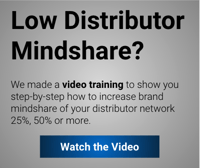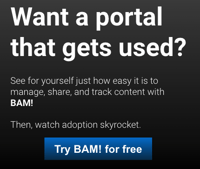Your channel sales teams deliver value to your organization in many ways: they cover a wide geographic area; they are the face of your company to the customer; they handle customer service and aftermarket needs; they sell and service your equipment. By developing trust with your dealers, you achieve the ultimate win-win: the OEM can continuously improve upon and launch new products, while the dealer channel can sell and service the products while hearing what customers really need.
As much value as they create, there are unique challenges to widely dispersed, 3rd-party sales organizations like dealers and distributors. We’ve listened to pain points of sales managers and channel sales teams, tweaking our mobile sales tools over many years to address these common points of inefficiency. Below are five of the most frequent refrains we’ve heard – along with how we’ve updated our mobile sales enablement platform to address them.
Pain Point #1: “Our sales training process is too slow.”
Training is one of the most difficult aspects of channel sales teams to influence. Dealers often have their own on-boarding processes, company cultures, and philosophical approach to brining new hires up to speed. As a result, new salespeople across different teams can have drastically different training experiences, resulting in habits, knowledge, and capabilities that can vary widely.
Some dealers are all too willing to throw a fresh-faced salesperson to the dogs on the first day – the “sink or swim” approach. This can and often does result in wasted leads and demoralized new employees. Other dealers are hesitant to let new hires get real experience – when every sale is vital, you have to be sure you’re bringing your A-game. The downfall of this strategy is overworking your top salespeople while prolonging the time before your new employees start delivering ROI.
Sales enablement technology standardizes training materials – it ensures that all of your new hires on sales teams around the globe are learning from the same playbook. This playbook can also be used during customer-facing situations. A mobile sales enablement tool puts comprehensive resource libraries in the hands of each and every salesperson, taking the guesswork out of product specs, cost of ownership, and custom options. For the confidence of a new salesperson (and for their manager), these resource libraries can make a world of difference.
Importantly, a sales tool with a visual product explorer offers a natural, unforced training experience that lets new reps explore they products in a way they understand. The new rep learns the product logically and by self-direction. This type of organic training not only puts the sales rep in the shoes of a customer who will be looking at the product for the first time, but it can reduce training time by as much as 50%.
Pain Point #2: “Admin work is a hassle and distraction.”
When interviewing channel sales teams, the most common statement is almost certainly, “I have too much admin work.” Salespeople of all types wish they had less paperwork to do so that they could focus more on what they are paid to do: sell. Top industry executives agree and see this as a problem – their best salespeople can be so bogged down with administrative work that the number of leads they can pursue per day is greatly reduced.
Sales enablement tech is designed to cut down on the amount of admin overhead for sales reps. Instant, cloud-based digital asset management ensures that all files are easy to find and always up-to-date, reducing time spent searching for files (possibly the most frustrating admin activity of all). Sales enablement tools also provide user-friendly ways to make notes, customize customer profiles, and update a centralized CRM. Being able to quickly and effectively create, find, and update files without worrying about organization or version control not only saves your team’s time, but grants greater peace of mind during sales situations. There are countless ways to create efficiencies and integrate with existing systems – sales enablement tools can take your sales process out of the paper age.
Pain Point #3: “It seems like each one of our sales reps uses the CRM differently.”
Ineffective use of CRM is one of the worst ways to lose business. You’ve done all the hard work, but if your CRM is difficult to use, not standardized, or not available remotely, chances are high that details will be lost in translation and sales may be jeopardized. A recent HubSpot survey identified CRM misusage as one of the biggest problems for sales managers.
Built-in, user-friendly CRM is one of the most vital aspects of a sales enablement tool. Lead prioritization, lead tracking, notes, automated reminders all contribute to a digital solution that makes managing customer relationships easier than ever. For the sales manager, this also makes management of your network of dealers much more efficient – you can track real-time data across all of your sales teams with information updated constantly from the cloud. Leads can be registered and updated immediately. Relying on salespeople remembering all the details of an hour long customer conversation until they get back to the office at the end of a long day is a thing of the past.
Pain Point #4: “I can’t get sales and marketing to communicate; they are completely misaligned.”
Leads can quickly be lost if salespeople are unfamiliar with the marketing materials that piqued their interest. This is why it’s vital to make sure sales and marketing are working as a single unified team. Of course, this can be difficult when your sales teams are 3rd party dealers dispersed over a large geographic area, and your marketing team is either in-house or also 3rd party. If you don’t have a specific plan to keep your sales and marketing teams on the same page, chances are they aren’t.
The digital asset management at the core of each sales enablement tool is built to do just that. You are in complete control of marketing materials and when an asset is updated once, it is updated everywhere. Salespeople can easily see which assets are the most recent. Notifications alert sales teams to new product information or new promotions to be aware of. Modules to facilitate communication can help sales teams influence future content creation with comments, suggestions, and data on what is effective and what isn’t when it comes to real sales situations.
Pain Point #5: “I don’t have an easy way to track performance across multiple sales teams.”
When sales teams are spread out and not standardized, it’s typical that performance tracking isn’t either. Different dealer practices result in different platforms, different KPIs, and different results. For managers, this can make it exceedingly difficult to compare performance of different dealers and salespeople.
Sales enablement tech allows you to establish what KPIs are important to you and to emphasize the importance of performance to your teams. Analytics related to dealers, salespeople, assets, products, and features give you a comprehensive view of your sales environment. Custom implementations can integrate with existing systems and give you new levels of insight. All this helps you understand asset performance and effectiveness while helping both sales and marketing teams improve productivity. Recognize what’s working and what isn’t, then set out to optimize.
Modernizing the Sales Process
To recap, there are five common pain points we’ve heard in our experience working with channel sales teams:
- “Our sales training process is too slow.”
- “Admin work is a hassle and distraction.”
- “It seems like each one of our sales reps uses the CRM differently.”
- “I can’t get sales and marketing to communicate; they are completely misaligned.”
- “I don’t have an easy way to track performance across multiple sales teams.”
Sales tools can be an effective way to modernize your sales process and address these issues head on. Of course, there are costs both in time and money to implement any new software in your business, but for most, the ROI is compelling and more than justifies the effort.


